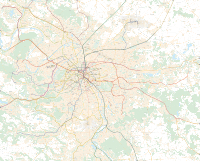CDGVAL
CDGVAL (Charles de Gaulle Véhicule Automatique Léger) is a free automatic shuttle rail service at Paris-Charles de Gaulle Airport consisting of two lines: a first line which opened on 4 April 2007 and a second on 27 June 2007. Based on the VAL system and using Siemens Transportation Systems VAL 208 coaches, the first five-station line links the three airport terminals, RER and TGV stations and remote car parks within 8 minutes.
| CDGVAL | |
|---|---|
| Overview | |
| Stations | 5 (1st line) 3 (2nd line) |
| Ridership | 10,000,000 journeys per year |
| Operation | |
| Opened | 2007 (last extension in 2012) |
| Rolling stock | VAL 208 |
| Technical | |
| Line length | 3.5 km (2.2 mi) |
Since 2015, the two lines are operated by Transdev on a 24-hour basis. The 60 million annual passengers of the airport and its 85,000 employees generate an annual traffic of 10 million journeys on CDGVAL.
History
The CDGVAL project replaced the SK6000 project, which was abandoned after unsuccessful test runs in 1999. CDGVAL was launched in 2000, with construction work beginning in 2003. Total cost is estimated at €145 million.
Charles de Gaulle is Europe's largest airport with an area of 3500 hectares. The airport terminals are relatively far apart. Terminal 2 opened in 1982. At that time links between terminals, including the rail link at Roissypole and the long-stay car parks, were achieved by a shuttle system of buses which progressively became an increasing percentage of airport road congestion. It was not uncommon for the journey between terminals to take nearly half an hour during peak periods. This problem revealed the requirement for a rapid and modern transport solution for airport users. Aéroports de Paris (ADP) planned to overhaul the transport system within the airport perimeter by introducing an internal train link.
The VAL metro system project was launched and project specific infrastructure work commenced shortly afterwards. After the project was under way in 1992, use of the SK6000 train system built by French company Soulé was imposed on ADP by the French government. Infrastructure had to be adapted and Line 1 was now due to open to the public on May 1, 1996. However, during testing the automated rail transit system did not perform as hoped revealing several flaws in the system. Deemed unreliable and incapable of meeting availability targets, ADP were forced to consider alternatives despite the amount already invested which had attained nearly 150 million Euros of state funds. In June 1999 the project was abandoned so ADP had to invest urgently in order to renew its fleet of ageing coaches and maintain road service. SK Line 2, which was due to open during the summer of 1997, was still nowhere near completion after almost one billion Francs invested. A new project codenamed CDGVAL was undertaken in 2000. Building on the original project, CDGVAL largely followed the SK path while adapting existing infrastructure to allow transit of automatic metro-type equipment. Work began in 2003.
Developed by Siemens Mobility France (previously Matra Transport then Siemens Transportation Systems), this train system has already equipped the French cities of Lille, Toulouse and Rennes, Italian city Turin and Chicago O'Hare International Airport. The company has supplied and installed seven trains with two VAL 208 cars each, automation, the command centre, track-side facilities, electrical installations and cabling, station floors and landings and workshop equipment.
The launch was initially forecast for autumn 2006, ten years after the scheduled opening for the SK6000 line, but the launch still underwent 6 further months delay. The first CDGVAL line opened to the public on April 4, 2007 after a full test run on March 19, 2007. The bus routes ran alongside the new tramway for the first ten days.
Passenger services
A travelator provides access to CDGVAL platform.
Caution: CDGVAL Shuttle has pickpockets active as it's open to anyone free of charge & passes through airport Parking PR and Parking PX stations. Pickpockets are adept at taking valuables that are often not secured properly.
CDGVAL serves also as transport for hotels situated within the boundaries of the airport. Do not to confuse CDGVAL & Hotel Shuttle Buses (Navette Bus): black line, pink line..) at Terminal 2 above CDG TGV rail station.
Detail of Connections to RER-B
The RER-B commuter line is a heavy-rail service to the Parisian region which is quite cheap.
Passengers for T1 or T2 connect to the RER-B via CDGVAL as follows: Terminal T2 has an RER-B platform in the train station directly underneath it; this station also handles the high-speed TGV, Eurostar, etc. Terminal T1 has no direct connection to the RER-B; instead, it connects at T3. There is then a short hop on the CDGVal to/from T1. The T3-to-T1 (i.e. CDGVAL) connection is uncomplicated, very user-friendly, modern, fast, and free.
Riders TO CDG should be aware that the RER-B trains become extremely crowded during the morning rush hour. Standing room only is the norm, and this is exacerbated by luggage. The evening rush hour is of no concern to North Atlantic passengers, since these Paris departure flights are universally scheduled for morning or early afternoon departure.
Travelers FROM CDG will have their choice of seats, since this is the terminus.
LISA
A second CDGVAL line, called LISA (Liaison Interne Satellite Aérogare), links Terminal 2E and the Terminal S3 and opened on 27 June 2007. With two stations and a length of 0.6 km (0.37 mi) it is located within the security controlled area of the airport and therefore accessible only to flight passengers.
Maps and stations
Line 1
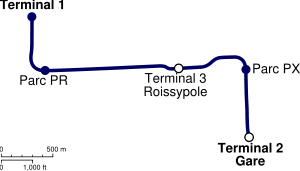
| Station | Facilities |
|---|---|
| Terminal 1 | CDG Terminal 1 |
| Parc PR | Parking area PR |
| Terminal 3 – Roissypole | CDG Terminal 3 Aéroport Charles de Gaulle 1 station |
| Parc PX | Parking area PX |
| Terminal 2 – Gare | CDG Terminal 2 Aéroport Charles de Gaulle 2 – TGV station |

Line 2
| Station | Facilities |
|---|---|
| Terminal 2E | K Gates |
| Satellite S3 | L Gates |
| Satellite S4 | M Gates |

Gallery
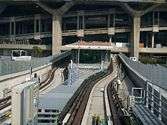 Terminal 1 station
Terminal 1 station- Terminal 2 station exterior
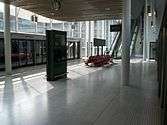 Terminal 2 station interior
Terminal 2 station interior Terminal 3 station
Terminal 3 station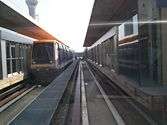 Park PR station looking east
Park PR station looking east Park PR station looking west
Park PR station looking west Park PX station
Park PX station- Terminal 2E station
- Satellite S3 station
